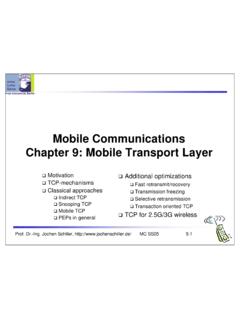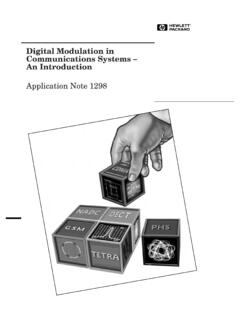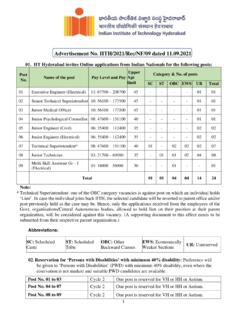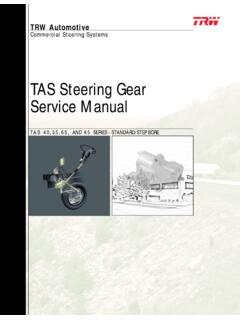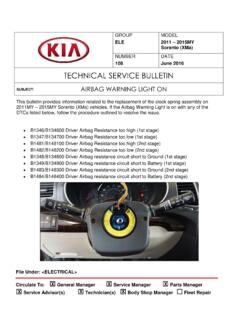Transcription of STEERING CONTROL MECHANISM
1 STEERING CONTROL . MECHANISM . AJMAL HUSSAIN (ME10B001). AKASH SUBUDHI (ME10B002). ALBIN ABRAHAM (ME10B003). PAWAN KUMAR (ME10B023). YOGITHA MALPOTH (ME10B024). ZAID AHSAN (ME10B043). SHANTI SWAROOP KANDALA (ME14 RESCH01001). OUTLINE. Introduction Types of STEERING Cad models Role of cornering stiffness Lateral CONTROL system Electric power assisted STEERING Optimization using genetic algorithm Conclusion INTRODUCTION. Collection of components which allows to follow the desired course. In a car : ensure that wheels are pointing in the desired direction of motion. Convert rotary motion of the STEERING to the angular turn of the wheel.
2 Mechanical advantage is used in this case. The joints and the links should be adjusted with precision. Smallest error can be dangerous MECHANISM should not transfer the shocks in the road to the driver's hands. It should minimize the wear on the tyres. RACK AND PINION STEERING SYSTEM. The pinion moves the rack converting circular motion into linear motion along a different axis Rack and pinion gives a good feedback there by imparts a feel to the driving Most commonly used system in automobiles now. Disadvantage of developing wear and there by backlash. RECIRCULATING BALL. Used in Older automobiles.
3 The STEERING wheel rotates the shaft which turns the worm gear.. Worm gear is fixed to the block and this moves the wheels.. More mechanical advantage.. More strength and durable . POWER STEERING . Too much physical exertion was needed for vehicles External power is only used to assist the STEERING effort. Power STEERING gives a feedback of forces acting on the front wheel to give a sense of how wheels are interacting with the road. Hydraulic and electric systems were developed. Also hybrid hydraulic-electric systems were developed. Even if the power fails, driver can steer only it becomes more heavier.
4 COMPONENTS. ELECTRIC POWER STEERING . Uses an electric motor to assist the driving Sensors detect the position of the STEERING column. An electronic module controls the effort to be applied depending on the conditions. The module can be customised to apply varying amounts of assistance depending on driving conditions. The assistance can also be tuned depending on vehicle type, driver preferences HYDRAULIC VS ELECTRIC. Electric eliminates the problems of dealing with leakage and disposal of the hydraulic fluid. Another issue is that if the hydraulic system fails, the driver will have to spent more effort since he has to turn the power assistance system as well as the vehicle using manual effort.
5 Hydraulic pump must be run constantly where as electric power is used accordingly and is more energy efficient. Hyrdraulic is more heavy, complicated, less durable and needs more maintenance. Hydraulic takes the power directly from the engine so less mileage. SPEED SENSITIVE STEERING . There is more assistance at lower speeds and less at higher speeds. Diravi is the first commercially available variable power STEERING system introduced by citroen. A centrifugal regulator driven by the secondary shaft of the gearbox gives a proportional hydraulic pressure to the speed of the car This pressure acts on a cam directly revolving according to the STEERING wheel.
6 This gives an artificial STEERING pressure by trying to turn back the STEERING to the central position Newer systems CONTROL the assistance directly AUDI R8. Comes in three variants coupe, sport and spyder. Audi r8 is hailed as one of the best road handling cars. Audi r8 beat the porsche 997- considered to be one of the best sports cars ever made in top gear's test. STEERING CAD MODEL. DYNAMIC ANALYSIS. tan f = tan + hf r/ U cos . tan r = tan + hr r/ U cos . f = - f; f = - - hf r/ U. r = r; r = - + hr r/ U hr FINAL EQUATIONS. STATE SPACE EQUATIONS. The matrices of the state space equations are given The elements of these matrices change due to variation in C and load The new matrices are A(1,1)=-(Cr+Cf)/(m*U).
7 A(2,1)=(hr*Cr-hf*Cf)/J;. calculated A(1,2)=-1+((hr*Cr-hf*Cf)/(m*(U^2)));. A(2,2)=-((hr^2)*Cr+(hf^2)*Cf)/(J*U);. B(1,1)=Cf/(m*U);. B(2,1)=hf*Cf/J;. sys=ss(A,B,C,D) C(1,1)=-((Cf+Cr)/m)+(ls*(hr*Cr-hf*Cf)/J) ;. C(1,2)=((hr*Cr-hf*Cf)/(m*U))-ls*(((hr^2) *Cr+(hf^2)*Cf)/(J*U));. C(2:3,1:2)=eye(2,2);. D(1,1)=(Cf/m)+ls*(hf*Cf/J);. The transfer functions are then given by, sys=ss(A,B,C,D);. tf(sys). tf()sys STABLE AND UNSTABLE REGIONS. VARYING CORNERING STIFFNESS. Stable region Slip angle Time M=3000 kg Yaw rate Time Lateral acc Time Slip angle Time M=4000 kg Yaw rate Time Lateral acc Time Slip angle Time M=5000 kg Yaw rate Time Lateral acc Time RESULTS.
8 Cornering Vehicle Settling Time Stiffness Peak mass (sec). (kN/deg). 1. 1000 Yaw rate No Lateral acc. 10. overshoot 2. 2000 Yaw rate Lateral acc. 3. 3000 Yaw rate Lateral acc. RESULTS. Cornering Vehicle Settling Time Stiffness Peak mass (sec). (kN/deg). 1. 4000 Yaw rate Lateral acc. 2. 5000 Yaw rate Lateral acc. 3. 6000 Yaw rate Lateral acc. LATERAL CONTROL SYSTEM. CONTROL strategy: look-down reference system Sensor at the front bumper to measure the lateral displacement GPS to measure the heading orientation Firstly, the road curvature estimator is designed based on the STEERING angle, which has STEERING angle and its derivative as two state variables for which an estimation algorithm is employed whose input comes from the sensor and the GPS data The closed loop controller is used as a compensator to CONTROL the lateral dynamics Precise and real-time estimation of the lateral displacements w.
9 R. T the road are accomplished using the proposed CONTROL system SINGLE TRACK DYNAMICS. Actuator Dynamics . X AX BU. d sf 80000.. 0. a 1 0 0 0 0 A( s) . d sf f a22 a21 a24 b 2 ( s )(s j )(s j ). X , U , A 21 , B 21. d .sr ref 0 0 0 1 0 g 4 .. d a41 a42 a41 a44 b41 2 . sr . Feedback Controller Dynamics . Structure C f ( s ) Cr ( s ) . g2 lsf g1 g l g lsf (lsr g1 g 3 ) g1 lsf g 2 lsf (lsf g1 g 3 ). a21 , a22 1 sr 2 , a22 K DDf s 2 K Df s K Pf M g 4 I g 4 M g 4 I g 4 KI. Mg 4 I g 4. C f (s) . g l g g l g l (l g g 3 ) g1 lsf g 2 lsr (lsf g1 g 3 ) s s 2 2 Ds s a41 2 sr 1 , a42 1 sr 2 sr sr 1 , a44 1 2 1.
10 M g 4 I g 4 M g 4 I g 4. Mg 4 I g 4. 2 1 1 . 1 lsf ltf 1 l l . b21 c f , b41 c f sr tf K DDr s 2 K Dr s K Pr M I M I Cr ( s ) . s s 2 2 Ds . g1 (cr ltr c f ltf ), g 2 (c f cr ), g 3 (cr ltr2 c f ltf2 ), g 4 lsf lsr 1 2 1 .. 2 1 1 . CONTROL SYSTEM. Lateral Position Estimation System . ^ ^ _ ^. X A X B U L( d sr H X ). ^ . d^sf .. ^. d . X ^sf . d sr . ^.. d sr . ^ f . U ^ . ref . 1 . 1 . X l . 1 . Implementation of CONTROL System . 1 . RESULTS. The lateral displacement result has no overshoot and is well damped. The STEERING angle and road curvature estimations are within accuracy specifications.



